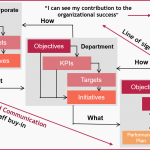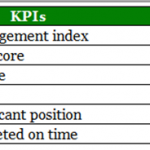Goal-setting: strategies, challenges and mistakes

Companies today are focused on delivering the best products and services to their customers. Achieving the expected results should start from setting realistic goals. Managers need to have an overview of the expected results, weed out unrealistic objectives and tend to the company’s needs in order to establish the most suitable organizational development path.
Effective goals have the following characteristics:
- Challenging: these should be realistic and suitable goals for each department or organization;
- Attainable: companies should make sure they set objectives that can be achieved and not create frustration between employees;
- Specific: include specific, concrete actions through which a certain goal can be attained;
- Time-limited: each goal needs to have a deadline in order for organizations to not to leave them hanging;
- Positive: goal-setting is all about getting things done and not about avoiding situations;
- Flexible: in an ever-changing environment, goals cannot stay the same. Adaptation is a required feature for effective goals.
Executives can meet certain challenges after setting goals for their companies. Objectives might not be assigned fairly across those responsible or the timeframe to achieve them is either too short or too long. Some of the challenges regarding the goal-setting process are detailed below:
- Goals are too high: in achieving high goals, employees might get demotivated due to the fact that the situations which they come across are very different from the expected ones and thus some objectives cannot be obtained;
- Goals are too low: on the other hand, establishing a low-scoped objective can make employees feel that their work is not challenging and engaging, which may have an unwanted effect on sales. Sometimes employees need a push to be efficient, do the best job they can and create more opportunities in obtaining money for their companies.
- Unfair allocation of goals among people: some employees are given low-scoped goals, while others receive objectives that are harder to achieve. This unfairness can lead to employees’ dissatisfaction regarding the differentiation between their rewards. The imbalance between these two components may have a negative impact on morale.
- Dynamic and complex environment: organizations cannot be entirely prepared for new opportunities, competitors and changes which appear in the business environment. Companies may find it difficult to set objectives in an innovative environment.
- Resistance to change: some organizations may encounter some issues in adapting their objectives when they are faced with changes in the organization or the environment.
- Constraints: companies can stumble upon some restrictions in setting goals, such as strong competition, lack of resources, delivery time and government restrictions.

If managers know these challenges before, during and after setting goals, then they will be prepared for every situation that may appear. Also, they should take into consideration the following strategies used for setting goals:
- Start with the ideal situation – managers should have in mind two things: the entirety of scenarios that may unfold and also the ideal vision regarding their expected results.
- Write down the goals – if an executive knows what he/she wants to attain, then these goals should be put on paper. This way, he/she can follow their objectives and have a clear perspective on each of them.
- Determine why these goals are important – sometimes executives have to make difficult choices regarding goals. They need to establish the importance of each and every one and in some cases they need to face the hard decision of leaving some of them behind.
- Craft clear-cut goals – managers should be specific in setting goals and they need to create clear objectives with clear action plans attached.
- Pursue a goal that is a tier one priority – he/she should prioritize the most important and achievable objectives.
- Set a target date – establishing deadlines for each objective helps a company know the evolution of each goal: which of them cannot be reached and which is almost to be fulfilled.
- Take small steps – a company should establish every step in reaching a goal. This way, every objective becomes clearer.
Even if goal-setting is done by following certain steps and strategies, mistakes can occur. Some of the most common ones are:
A. Underestimating completion time – by not estimating the correct completion time, managers can generate frustration, discouragement and even cause some employees to give up;
B. Not appreciating failure – companies should be able to learn from their mistakes and use this knowledge for future prospects;
C. Not reviewing processes – every organization should use a reviewing process in order to analyze accomplishments, failures, take corrective actions and update its objectives;
D. Setting negative goals – formulating a goal should be done in a positive manner, because it influences the way employees think about it;
E. Setting too many goals – if a company tries to concentrate on too many goals at the same time, then there is a distinct possibility that only a few of them will be achieved.
Goal-setting needs to be a process in which companies can establish achievable objectives in a realistic time-frame. Managers should be aware of the goals’ characteristics, steps in establishing them and any mistakes that can occur along the way.
If I were to give my own take on the topic, I would say that setting realistic goals is the most important step in ensuring an organization’s market success.
Image source:

Tags: Objectives, operational performance, target setting





